Harmony:
One of the signatures of the genre is the guitar power chord. In technical terms, the power chord is relatively simple: it involves just one main interval, generally the perfect fifth, though an octave may be added as a doubling of the root. Although the perfect fifth interval is the most common basis for the power chord, power chords are also based on different intervals such as the minor third, major third, perfect fourth, diminished fifth, or minor sixth. Most power chords are also played with a consistent finger arrangement that can be slid easily up and down the fretboard.Typical harmonic structures:
Heavy metal is usually based on riffs created with three main harmonic traits: modal scale progressions, tritone and chromatic progressions, and the use of pedal points. Traditional heavy metal tends to employ modal scales, in particular the Aeolian and Phrygian modes. Harmonically speaking, this means the genre typically incorporates modal chord progressions such as the Aeolian progressions I-VI-VII, I-VII-(VI), or I-VI-IV-VII and Phrygian progressions implying the relation between I and ♭II (I-♭II-I, I-♭II-III, or I-♭II-VII for example). Tense-sounding chromatic or tritone relationships are used in a number of metal chord progressions.The tritone, an interval spanning three whole tones—such as C and F#—was a forbidden dissonance in medieval ecclesiastical singing, which led monks to call it diabolus in musica—"the devil in music." Because of that original symbolic association, it came to be heard in Western cultural convention as "evil". Heavy metal has made extensive use of the tritone in guitar solos and riffs, such as in the beginning of "Black Sabbath".
Heavy metal songs often make extensive use of pedal point as a harmonic basis. A pedal point is a sustained tone, typically in the bass range, during which at least one foreign (i.e., dissonant) harmony is sounded in the other parts.
Relationship with classical music:

Ritchie Blackmore, founder of Deep Purple and Rainbow, known for the neoclassical approach in his guitar performances
In an article written for Grove Music Online, Walser states that the "1980s brought on ...the widespread adaptation of chord progressions and virtuosic practices from 18th-century European models, especially Bach, Wagner and Vivaldi, by influential guitarists such as Ritchie Blackmore, Marty Friedman, Jason Becker, Uli Jon Roth, Eddie Van Halen, Randy Rhoads and Yngwie Malmsteen".Kurt Bachmann of Believer has stated that "If done correctly, metal and classical fit quite well together. Classical and metal are probably the two genres that have the most in common when it comes to feel, texture, creativity."
Although a number of metal musicians cite classical composers as inspiration, classical and metal are rooted in different cultural traditions and practices—classical in the art music tradition, metal in the popular music tradition. As musicologists Nicolas Cook and Nicola Dibben note, "Analyses of popular music also sometimes reveal the influence of 'art traditions.' An example is Walser's linkage of heavy metal music with the ideologies and even some of the performance practices of nineteenth-century Romanticism. However, it would be clearly wrong to claim that traditions such as blues, rock, heavy metal, rap or dance music derive primarily from 'art music.'
Lyrical themes:
Black Sabbath and the many metal bands they inspired have concentrated lyrically "on dark and depressing subject matter to an extent hitherto unprecedented in any form of pop music," according to scholars David Hatch and Stephen Millward. They take as an example Sabbath's second album Paranoid (1970), which "included songs dealing with personal trauma—'Paranoid' and 'Fairies Wear Boots' (which described the unsavoury side effects of drug-taking) —as well as those confronting wider issues, such as the self-explanatory 'War Pigs' and 'Hand of Doom.'"Nuclear annihilation was addressed in later metal songs such as Black Sabbath's "Electric Funeral", Iron Maiden's "2 Minutes to Midnight", Ozzy Osbourne's "Killer of Giants", Megadeth's "Rust in Peace... Polaris", and Metallica's "Fight Fire with Fire". Death is a predominant theme in heavy metal, routinely featuring in the lyrics of bands as otherwise widely different as Slayer and W.A.S.P. The more extreme forms of death metal and grindcore tend to have aggressive and gory lyrics.
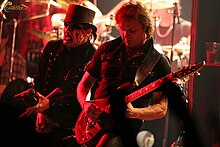
King Diamond, known for writing conceptual lyrics about horror stories
Led Zeppelin lyrics often make reference to The Lord of the Rings as well as other mythology and folklore, such as in the songs "The Battle of Evermore", "Immigrant Song", "Ramble On", "No Quarter", and "Achilles Last Stand". Other examples include Black Sabbath's "The Wizard", Megadeth's "The Conjuring" and "Five Magics", and Judas Priest's "Dreamer Deceiver". Since the 1980s, with the rise of thrash metal and songs such as Metallica's "...And Justice for All" and Megadeth's "Peace Sells", more metal lyrics have included socio-political commentary. Genres such as melodic death metal, progressive metal, and black metal often explore philosophical themes.
The thematic content of heavy metal has long been a target of criticism. According to Jon Pareles, "Heavy metal's main subject matter is simple and virtually universal. With grunts, moans and subliterary lyrics, it celebrates...a party without limits.... [T]he bulk of the music is stylized and formulaic." Music critics have often deemed metal lyrics juvenile and banal, and others have objected to what they see as advocacy of misogyny and the occult. During the 1980s, the Parents Music Resource Center petitioned the U.S. Congress to regulate the popular music industry due to what the group asserted were objectionable lyrics, particularly those in heavy metal songs. Music critic Robert Christgau called metal "an expressive mode it sometimes seems will be with us for as long as ordinary whiteboys fear girls, pity themselves, and are permitted to rage against a world they'll never beat".
In 1990, Judas Priest was sued in American court by the parents of two young men who had shot themselves five years earlier, allegedly after hearing the subliminal statement "do it" in a Priest song. While the case attracted a great deal of media attention, it was ultimately dismissed.In some predominantly Muslim countries, heavy metal has been officially denounced as a threat to traditional values. In countries such as Morocco, Egypt, Lebanon, and Malaysia, there have been incidents of heavy metal musicians and fans being arrested and incarcerated.
Image and fashion:
Main article: Heavy metal fashion

Kiss performing in 2004, wearing makeup
Down-the-back long hair, according to Weinstein, is the "most crucial distinguishing feature of metal fashion." Originally adopted from the hippie subculture, by the 1980s and 1990s heavy metal hair "symbolised the hate, angst and disenchantment of a generation that seemingly never felt at home," according to journalist Nader Rahman. Long hair gave members of the metal community "the power they needed to rebel against nothing in general."
The classic uniform of heavy metal fans consists of light colored, ripped frayed or torn blue jeans, black T-shirts, boots and black leather or jeans jackets.... T-shirts are generally emblazoned with the logos or other visual representations of favorite metal bands." Metal fans also "appropriated elements from the S&M community (chains, metal studs, skulls, leather and crosses)." In the 1980s, a range of sources, from punk and goth music to horror films, influenced metal fashion. Many metal performers of the 1970s and 1980s used radically shaped and brightly colored instruments to enhance their stage appearance.
Fashion and personal style was especially important for glam metal bands of the era. Performers typically wore long, dyed, hairspray-teased hair (hence the nickname, "hair metal"); makeup such as lipstick and eyeliner; gaudy clothing, including leopard-skin-printed shirts or vests and tight denim, leather, or spandex pants; and accessories such as headbands and jewelry. Pioneered by the heavy metal act X Japan in the late 1980s, bands in the Japanese movement known as visual kei—which includes many nonmetal groups—emphasize elaborate costumes, hair, and makeup.
Physical gestures:
Attendees of metal concerts do not dance in the usual sense; Deena Weinstein has argued that this is due to the music's largely male audience and "extreme heterosexualist ideology." She identifies two primary body movements that substitute for dancing: headbanging and an arm thrust that is both a sign of appreciation and a rhythmic gesture. The performance of air guitar is popular among metal fans both at concerts and listening to records at home. Other concert audience activities include stage diving, crowd surfing, pushing and shoving in a chaotic mêlée called moshing, and displaying the corna hand symbol.
Fan subculture:
Main article: Heavy metal subculture
Deena Weinstein
argues that heavy metal has outlasted many other rock genres largely
due to the emergence of an intense, exclusionary, strongly masculine
subculture.
While the metal fanbase is largely young, white, male, and blue-collar,
the group is "tolerant of those outside its core demographic base who
follow its codes of dress, appearance, and behavior."
Identification with the subculture is strengthened not only by the
shared experience of concert-going and shared elements of fashion, but
also by contributing to metal magazines and, more recently, websites.
A heavy metal fan wearing a denim jacket with band patches and artwork of the heavy metal bands Metallica, Guns N' Roses, Iron Maiden, Slipknot and Led Zeppelin
Musician and filmmaker Rob Zombie observes, "Most of the kids who come to my shows seem like really imaginative kids with a lot of creative energy they don't know what to do with" and that metal is "outsider music for outsiders. Nobody wants to be the weird kid; you just somehow end up being the weird kid. It's kind of like that, but with metal you have all the weird kids in one place."Scholars of metal have noted the tendency of fans to classify and reject some performers (and some other fans) as "poseurs" "who pretended to be part of the subculture, but who were deemed to lack authenticity and sincerity."
Etymology:
The origin of the term "heavy metal" in a musical context is uncertain. The phrase has been used for centuries in chemistry and metallurgy, where the periodic table organizes elements of both light and heavy metals (e.g. uranium). An early use of the term in modern popular culture was by countercultural writer William S. Burroughs. His 1962 novel The Soft Machine includes a character known as "Uranian Willy, the Heavy Metal Kid." Burroughs's next novel, Nova Express (1964), develops the theme, using heavy metal as a metaphor for addictive drugs: "With their diseases and orgasm drugs and their sexless parasite life forms—Heavy Metal People of Uranus wrapped in cool blue mist of vaporized bank notes—And The Insect People of Minraud with metal music." The phrase was later lifted by Sandy Pearlman, who used the term to describe The Byrds for their supposed "aluminium style of context and effect", particularly on their album The Notorious Byrd Brothers (1968).Metal historian Ian Christe describes what the components of the term mean in "hippiespeak": "heavy" is roughly synonymous with "potent" or "profound," and "metal" designates a certain type of mood, grinding and weighted as with metal. The word "heavy" in this sense was a basic element of beatnik and later countercultural slang, and references to "heavy music"—typically slower, more amplified variations of standard pop fare—were already common by the mid-1960s. Iron Butterfly's debut album, released in early 1968, was titled Heavy. The first use of "heavy metal" in a song lyric is in reference to a motorcycle in the Steppenwolf song "Born to Be Wild", also released that year:[58] "I like smoke and lightning/Heavy metal thunder/Racin' with the wind/And the feelin' that I'm under." A late, and disputed, claim about the source of the term was made by "Chas" Chandler, former manager of the Jimi Hendrix Experience. In a 1995 interview on the PBS program Rock and Roll, he asserted that heavy metal "was a term originated in a New York Times article reviewing a Jimi Hendrix performance," in which the author likened the event to "listening to heavy metal falling from the sky." A source for Chandler's claim has never been found.
The first documented use of the phrase to describe a type of rock music identified to date appears in a review by Barry Gifford. In the May 11, 1968, issue of Rolling Stone, he wrote about the album A Long Time Comin' by U.S. band Electric Flag: "Nobody who's been listening to Mike Bloomfield—either talking or playing—in the last few years could have expected this. This is the new soul music, the synthesis of white blues and heavy metal rock." In January 1970 Lucian K. Truscott IV reviewing Led Zeppelin II for the Village Voice described the sound as "heavy" and made comparisons with Blue Cheer and Vanilla Fudge.
Other early documented uses of the phrase are from reviews by critic Mike Saunders. In the November 12, 1970, issue of Rolling Stone, he commented on an album put out the previous year by the British band Humble Pie: "Safe as Yesterday Is, their first American release, proved that Humble Pie could be boring in lots of different ways. Here they were a noisy, unmelodic, heavy metal-leaden shit-rock band with the loud and noisy parts beyond doubt. There were a couple of nice songs...and one monumental pile of refuse." He described the band's latest, self-titled release as "more of the same 27th-rate heavy metal crap."
In a review of Sir Lord Baltimore's Kingdom Come in the May 1971 Creem, Saunders wrote, "Sir Lord Baltimore seems to have down pat most all the best heavy metal tricks in the book."[62] Creem critic Lester Bangs is credited with popularizing the term via his early 1970s essays on bands such as Led Zeppelin and Black Sabbath. Through the decade, heavy metal was used by certain critics as a virtually automatic putdown. In 1979, lead New York Times popular music critic John Rockwell described what he called "heavy-metal rock" as "brutally aggressive music played mostly for minds clouded by drugs," and, in a different article, as "a crude exaggeration of rock basics that appeals to white teenagers."
Coined by Black Sabbath drummer, Bill Ward, "downer rock" was one of the earliest terms used to describe this style of music and was applied to acts such as Sabbath and Bloodrock. Classic Rock magazine described the downer rock culture revolving around the use of Quaaludes and the drinking of wine. Later the term would be replaced by "heavy metal."
The terms "heavy metal" and "hard rock" have often been used interchangeably, particularly in discussing bands of the 1970s, a period when the terms were largely synonymous. For example, the 1983 Rolling Stone Encyclopedia of Rock & Roll includes this passage: "known for its aggressive blues-based hard-rock style, Aerosmith was the top American heavy-metal band of the mid-Seventies."
History:
Antecedents: 1950s to mid-1960s
Heavy metal's quintessential guitar style, built around distortion-heavy riffs and power chords, traces its roots to early 1950s Memphis electric blues guitarists such as Joe Hill Louis, Willie Johnson, and particularly Pat Hare,[70][71] who captured a "grittier, nastier, more ferocious electric guitar sound" on records such as James Cotton's "Cotton Crop Blues" (1954); the late 1950s instrumentals of Link Wray, particularly "Rumble" (1958); the early 1960s surf rock music of Dick Dale, including "Let's Go Trippin'" (1961) and "Misirlou" (1962); and The Kingsmen's version of "Louie, Louie" (1963), which made it a garage rock standard.However, the genre's direct lineage begins in the mid-1960s. American blues music was a major influence on the early British rockers of the era. Bands like The Rolling Stones and The Yardbirds developed blues rock by recording covers of many classic blues songs, often speeding up the tempos. As they experimented with the music, the UK blues-based bands—and the U.S. acts they influenced in turn—developed what would become the hallmarks of heavy metal, in particular, the loud, distorted guitar sound. The Kinks played a major role in popularizing this sound with their 1964 hit "You Really Got Me".
In addition to The Kinks' Dave Davies, other guitarists such as The Who's Pete Townshend and The Yardbirds' Jeff Beck were experimenting with feedback. Where the blues rock drumming style started out largely as simple shuffle beats on small kits, drummers began using a more muscular, complex, and amplified approach to match and be heard against the increasingly loud guitar. Vocalists similarly modified their technique and increased their reliance on amplification, often becoming more stylized and dramatic. In terms of sheer volume, especially in live performance, The Who's "bigger-louder-wall-of-Marshalls" approach was seminal.
The combination of blues rock with psychedelic rock formed much of the original basis for heavy metal. One of the most influential bands in forging the merger of genres was the British power trio Cream, who derived a massive, heavy sound from unison riffing between guitarist Eric Clapton and bassist Jack Bruce, as well as Ginger Baker's double bass drumming.Their first two LPs, Fresh Cream (1966) and Disraeli Gears (1967), are regarded as essential prototypes for the future style. The Jimi Hendrix Experience's debut album, Are You Experienced (1967), was also highly influential. Hendrix's virtuosic technique would be emulated by many metal guitarists and the album's most successful single, "Purple Haze", is identified by some as the first heavy metal hit.
During the late sixties, many psychedelic singers such as Arthur Brown, began to create outlandish, theatrical and often macabre performances; which in itself became incredibly influential to many metal acts. Vanilla Fudge, whose first album also came out in 1967, has been called "one of the few American links between psychedelia and what soon became heavy metal."
Origins: late 1960s and early 1970s:
See also: Traditional heavy metal
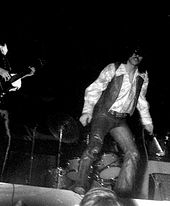
John Kay of Steppenwolf
The Jeff Beck Group, whose leader had preceded Page as The Yardbirds' guitarist, released its debut record that same month: Truth featured some of the "most molten, barbed, downright funny noises of all time," breaking ground for generations of metal ax-slingers. In October, Page's new band, Led Zeppelin, made its live debut. The Beatles' so-called White Album, which also came out that month, included "Birthday" and "Helter Skelter", then one of the heaviest-sounding songs ever released by a major band. The Pretty Things' rock opera S.F. Sorrow, released in December, featured "proto heavy metal" songs such as "Old Man Going" and "I See You".
In this period MC5, who began as part of the Detroit garage rock scene, developed a raw distorted style that has been seen as a major influence on the future sound of both heavy metal and later punk music. The Stooges also began to establish and influence a heavy metal and later punk sound, with songs such as "I Wanna Be Your Dog", featuring pounding and distorted heavy guitar power chord riffs. Pink Floyd released two of their heaviest and loudest songs to date; "Ibiza Bar" and "The Nile Song", which was regarded as "one of the heaviest songs the band recorded".
In January 1969, Led Zeppelin's self-titled debut album was released and reached number 10 on the Billboard album chart. In July, Zeppelin and a power trio with a Cream-inspired, but cruder sound, Grand Funk Railroad, played the Atlanta Pop Festival. That same month, another Cream-rooted trio led by Leslie West released Mountain, an album filled with heavy blues rock guitar and roaring vocals. In August, the group—now itself dubbed Mountain—played an hour-long set at the Woodstock Festival.Grand Funk's debut album, On Time, also came out that month. In the fall, Led Zeppelin II went to number 1 and the album's single "Whole Lotta Love" hit number 4 on the Billboard pop chart. The metal revolution was under way.
Led Zeppelin defined central aspects of the emerging genre, with Page's highly distorted guitar style and singer Robert Plant's dramatic, wailing vocals. Other bands, with a more consistently heavy, "purely" metal sound, would prove equally important in codifying the genre. The 1970 releases by Black Sabbath (Black Sabbath and Paranoid) and Deep Purple (In Rock) were crucial in this regard.

Brian Robertson, Phil Lynott, Scott Gorham of Thin Lizzy performing during the Bad Reputation Tour, 24 November 1977
As described above, there are arguments about whether these and other early bands truly qualify as "heavy metal" or simply as "hard rock". Those closer to the music's blues roots or placing greater emphasis on melody are now commonly ascribed the latter label. AC/DC, which debuted with High Voltage in 1975, is a prime example. The 1983 Rolling Stone encyclopedia entry begins, "Australian heavy-metal band AC/DC..." Rock historian Clinton Walker writes, "Calling AC/DC a heavy metal band in the seventies was as inaccurate as it is today.... [They] were a rock 'n' roll band that just happened to be heavy enough for metal." The issue is not only one of shifting definitions, but also a persistent distinction between musical style and audience identification: Ian Christe describes how the band "became the stepping-stone that led huge numbers of hard rock fans into heavy metal perdition."
In certain cases, there is little debate. After Black Sabbath, the next major example is Britain's Judas Priest, which debuted with Rocka Rolla in 1974. In Christe's description,
"Black Sabbath's audience was...left to scavenge for sounds with similar impact. By the mid-1970s, heavy metal aesthetic could be spotted, like a mythical beast, in the moody bass and complex dual guitars of Thin Lizzy, in the stagecraft of Alice Cooper, in the sizzling guitar and showy vocals of Queen, and in the thundering medieval questions of Rainbow.... Judas Priest arrived to unify and amplify these diverse highlights from hard rock's sonic palette. For the first time, heavy metal became a true genre unto itself."Though Judas Priest did not have a top 40 album in the U.S. until 1980, for many it was the definitive post-Sabbath heavy metal band; its twin-guitar attack, featuring rapid tempos and a nonbluesy, more cleanly metallic sound, was a major influence on later acts. While heavy metal was growing in popularity, most critics were not enamored of the music. Objections were raised to metal's adoption of visual spectacle and other trappings of commercial artifice, but the main offense was its perceived musical and lyrical vacuity: reviewing a Black Sabbath album in the early 1970s, leading critic Robert Christgau described it as "dull and decadent...dim-witted, amoral exploitation."
Mainstream: late 1970s and 1980s:
Punk rock emerged in the mid-1970s as a reaction against contemporary social conditions as well as what was perceived as the overindulgent, overproduced rock music of the time, including heavy metal. Sales of heavy metal records declined sharply in the late 1970s in the face of punk, disco, and more mainstream rock. With the major labels fixated on punk, many newer British heavy metal bands were inspired by the movement's aggressive, high-energy sound and "lo-fi", do it yourself ethos. Underground metal bands began putting out cheaply recorded releases independently to small, devoted audiences.Motörhead, founded in 1975, was the first important band to straddle the punk/metal divide. With the explosion of punk in 1977, others followed. British music papers such as the NME and Sounds took notice, with Sounds writer Geoff Barton christening the movement the "New Wave of British Heavy Metal". NWOBHM bands including Iron Maiden, Saxon, and Def Leppard reenergized the heavy metal genre. Following the lead set by Judas Priest and Motörhead, they toughened up the sound, reduced its blues elements, and emphasized increasingly fast tempos.
In 1980, the NWOBHM broke into the mainstream, as albums by Iron Maiden and Saxon, as well as Motörhead, reached the British top 10. Though less commercially successful, other NWOBHM bands such as Venom and Diamond Head would have a significant influence on metal's development. In 1981, Motörhead became the first of this new breed of metal bands to top the UK charts with No Sleep 'til Hammersmith.
The first generation of metal bands was ceding the limelight. Deep Purple had broken up soon after Blackmore's departure in 1975, and Led Zeppelin broke up following drummer John Bonham's death in 1980. Black Sabbath was routinely upstaged in concert by its opening act, the Los Angeles band Van Halen. Eddie Van Halen established himself as one of the leading metal guitarists of the era—his solo on "Eruption", from the band's self-titled 1978 album, is considered a milestone.
Inspired by Van Halen's success, a metal scene began to develop in Southern California during the late 1970s. Based on the clubs of L.A.'s Sunset Strip, bands such as Quiet Riot, Ratt, Mötley Crüe, and W.A.S.P. were influenced by traditional heavy metal of the earlier 1970sand incorporated the theatrics (and sometimes makeup) of glam rock acts such as Alice Cooper and Kiss. The lyrics of these glam metal bands characteristically emphasized hedonism and wild behavior. Musically, the style was distinguished by rapid-fire shred guitar solos, anthemic choruses, and a relatively pop-oriented melodic approach. The glam metal movement—along with similarly styled acts such as New York's Twisted Sister—became a major force in metal and the wider spectrum of rock music.
Between 1983 and 1984, heavy metal went from an 8 percent to a 20 percent share of all recordings sold in the U.S. Several major professional magazines devoted to the genre were launched, including Kerrang! (in 1981) and Metal Hammer (in 1984), as well as a host of fan journals. In 1985, Billboard declared, "Metal has broadened its audience base. Metal music is no longer the exclusive domain of male teenagers. The metal audience has become older (college-aged), younger (pre-teen), and more female."
By the mid-1980s, glam metal was a dominant presence on the U.S. charts, music television, and the arena concert circuit. New bands such as L.A.'s Warrant and acts from the East Coast like Poison and Cinderella became major draws, while Mötley Crüe and Ratt remained very popular. Bridging the stylistic gap between hard rock and glam metal, New Jersey's Bon Jovi became enormously successful with its third album, Slippery When Wet (1986). The similarly styled Swedish band Europe became international stars with The Final Countdown (1986). Its title track hit number 1 in 25 countries. In 1987, MTV launched a show, Headbanger's Ball, devoted exclusively to heavy metal videos. However, the metal audience had begun to factionalize, with those in many underground metal scenes favoring more extreme sounds and disparaging the popular style as "light metal" or "hair metal."
One band that reached diverse audiences was Guns N' Roses. In contrast to their glam metal contemporaries in L.A., they were seen as much more raw and dangerous. With the release of their chart-topping Appetite for Destruction (1987), they "recharged and almost single-handedly sustained the Sunset Strip sleaze system for several years."The following year, Jane's Addiction emerged from the same L.A. hard-rock club scene with its major label debut, Nothing's Shocking. Reviewing the album, Rolling Stone declared, "as much as any band in existence, Jane's Addiction is the true heir to Led Zeppelin." The group was one of the first to be identified with the "alternative metal" trend that would come to the fore in the next decade. Meanwhile, new bands such as New York's Winger and New Jersey's Skid Row sustained the popularity of the glam metal style.
 :
:
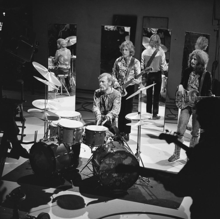
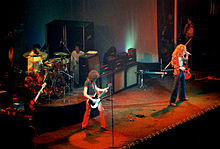
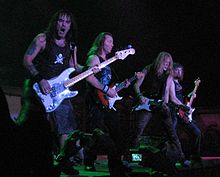
No comments:
Post a Comment